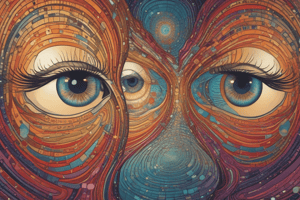Podcast
Questions and Answers
What is the role of the visual cortex in perceiving depth and distance?
What is the role of the visual cortex in perceiving depth and distance?
- Calculating the parallax difference between images captured by each eye
- Creating a three-dimensional representation of the world
- Interpreting the differences in images due to varying eye positions
- Comparing the images and determining an object's relative distance and depth (correct)
What is binocular disparity based on in stereoscopic vision?
What is binocular disparity based on in stereoscopic vision?
- Differences in visual processing
- Differences in images captured by each eye due to their different positions (correct)
- Differences in color perception
- Differences in eye injuries
How can stereopsis be impacted according to the text?
How can stereopsis be impacted according to the text?
- Misalignment of the visual cortex
- Eye injuries, misalignment, and visual processing disorders (correct)
- Difficulty perceiving colors
- Overlapping images captured by both eyes
What does the text suggest about the human brain's processing of binocular disparities?
What does the text suggest about the human brain's processing of binocular disparities?
How does stereopsis enhance our understanding of the world according to the text?
How does stereopsis enhance our understanding of the world according to the text?
Flashcards are hidden until you start studying
Study Notes
Two Eyes: Seeing the World in Three Dimensions
Humans are unique in many ways, and one of the most fascinating aspects is our ability to perceive the world in three dimensions. This incredible skill wouldn't be possible without our two eyes. In this article, we'll delve into the scientific reasons behind our ability to see the third dimension, and the role our eyes play in making this possible.
How Do Our Eyes Work?
Our eyes are complex organs that convert light into electrical signals, which our brain interprets as images. Each eye contains millions of cells called photoreceptors, which are mainly rods and cones, responsible for detecting light and color. Once light enters the eye, it passes through the cornea, pupil, and lens before reaching the photoreceptors at the back of the eye, the retina.
Perceiving Depth: Stereopsis
Our brain's ability to perceive depth, or the third dimension, relies on a phenomenon called stereopsis. Stereopsis occurs because our eyes are slightly apart, and they each receive a slightly different image of the world due to their different perspectives. Our brain combines these two slightly different images to create a single, three-dimensional view of our surroundings.
How Our Brain Processes Stereopsis
Our brain has a specialized region called the visual cortex that's responsible for processing the information received from our eyes. The visual cortex compares the two images and calculates the parallax difference between them, which is the change in perspective observed when viewing an object from different positions. The brain then uses this information to determine an object's relative distance and depth.
Stereoscopic Vision and Binocular Disparity
Stereoscopic vision is based on binocular disparity, the differences in the images captured by each eye due to their different positions. These differences are small, and the human brain is highly skilled at processing and interpreting them to create a three-dimensional representation of the world.
Stereopsis Can Be Impacted
Stereopsis can be affected by a variety of factors, including eye injuries, misalignment, and visual processing disorders. In some cases, people may have difficulties perceiving depth or experiencing depth distortions. However, most people have normal or near-normal stereopsis, and this ability to see in three dimensions significantly enhances our understanding and experience of the world.
Conclusion
Our two eyes provide us with a remarkable ability to perceive the three-dimensional world around us. Stereopsis, the process by which our brain processes the differences in images captured by our two eyes, is key to this ability. While the underlying processes may be complex, the result is a richer, more immersive experience of the world. And the next time you look at something in 3D, remember that it wouldn't be possible without your two eyes and their amazing ability to process the world in three dimensions.
Studying That Suits You
Use AI to generate personalized quizzes and flashcards to suit your learning preferences.




